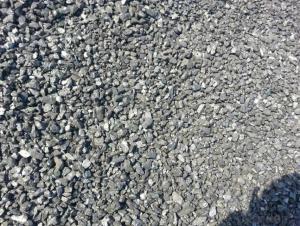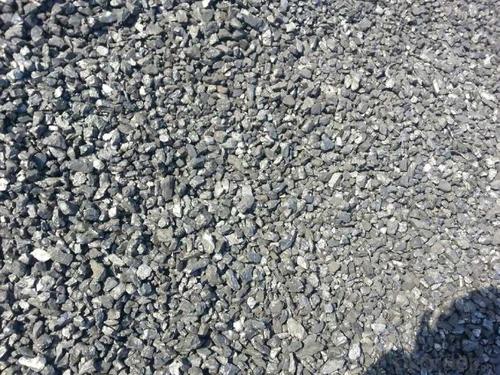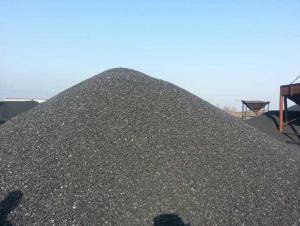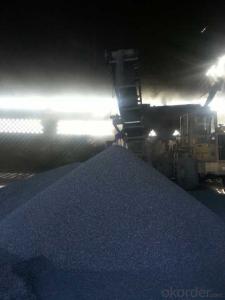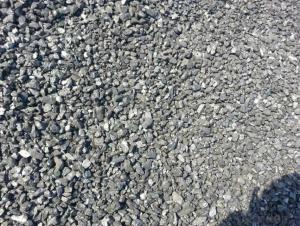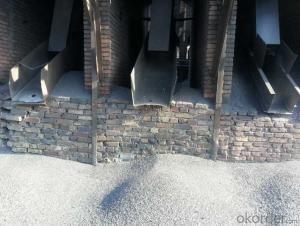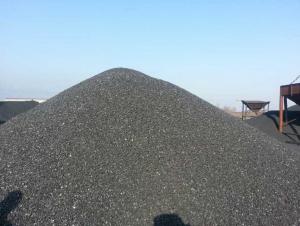FC90 Injection Carbon with good and stable quality
- Loading Port:
- Tianjin
- Payment Terms:
- TT OR LC
- Min Order Qty:
- 20 m.t.
- Supply Capability:
- 3000 m.t./month
OKorder Service Pledge
OKorder Financial Service
You Might Also Like
Packaging & Delivery
25kgs/50kgs/1ton per bag or as buyer's request
Specifications
Calcined Anthracite
Fixed carbon: 90%-95%
S: 0.5% max
Size: 0-3. 3-5.3-15 or as request
It used the high quality anthracite as raw materials through high temperature calcined at over 2000 by the DC electric calciner with results in eliminating the moisture and volatile matter from anthracite efficiently, improving the density and the electric conductivity and strengthening the mechanical strength and anti-oxidation. It has good characteristics with low ash, low resistvity, low sulphur, high carbon and high density. It is the best material for high quality carbon products.
Advantage and competitive of caclined anthracite:
1. strong supply capability
2. fast transportation
3. lower and reasonable price for your reference
4.low sulphur, low ash
5.fixed carbon:95% -90%
6..sulphur:lower than 0.3%
General Specification of Calcined Anthracite:
| FC % | 95 | 94 | 93 | 92 | 90 |
| ASH % | 4 | 5 | 6 | 6.5 | 8.5 |
| V.M. % | 1 | 1 | 1 | 1.5 | 1.5 |
| S % | 0.3 | 0.3 | 0.3 | 0.35 | 0.35 |
| MOISTURE % | 0.5 | 0.5 | 0.5 | 0.5 | 0.5 |
Pictures
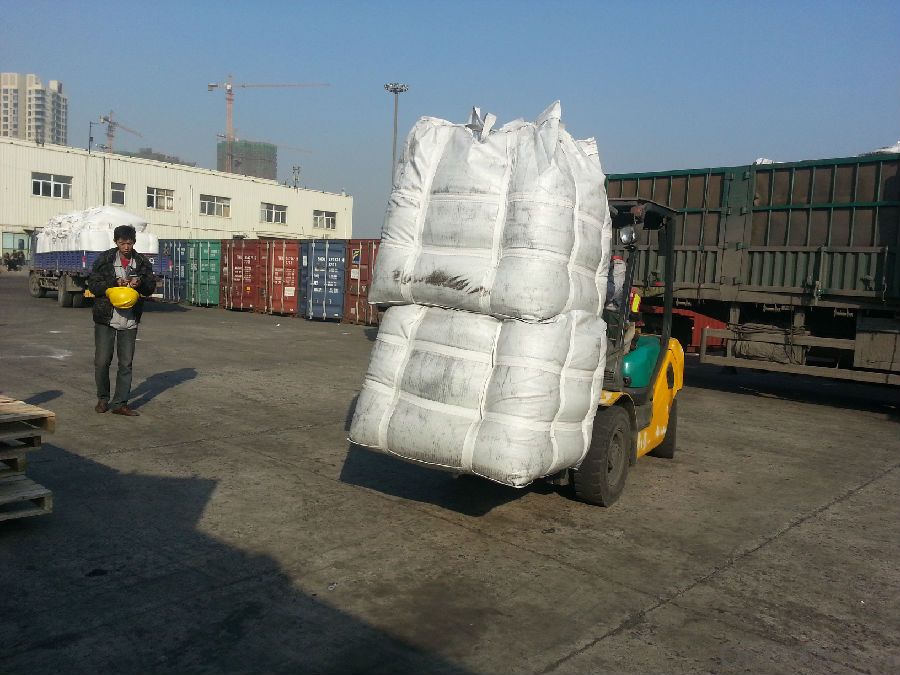

- Q: How does carbon dioxide affect global warming?
- Carbon dioxide is one of the primary greenhouse gases responsible for global warming. When released into the atmosphere, carbon dioxide traps heat from the sun and prevents it from escaping back into space, thus leading to an increase in the Earth's overall temperature. This phenomenon is often referred to as the greenhouse effect, where the Earth's atmosphere acts like the glass walls of a greenhouse, trapping heat and warming the planet. Human activities, such as burning fossil fuels for energy, deforestation, and industrial processes, have significantly increased the concentration of carbon dioxide in the atmosphere. These activities have released vast amounts of carbon dioxide that would have otherwise remained stored underground for millions of years. As a result, the concentration of carbon dioxide in the atmosphere has reached levels unseen for hundreds of thousands of years. The increase in carbon dioxide levels enhances the greenhouse effect and intensifies global warming. Rising temperatures have various adverse effects on the Earth's climate system. They contribute to the melting of polar ice caps and glaciers, leading to rising sea levels. This process threatens coastal communities and low-lying areas with increased risk of flooding and coastal erosion. Additionally, global warming disrupts weather patterns, leading to more frequent and severe extreme weather events, such as hurricanes, droughts, and heatwaves. Furthermore, global warming affects ecosystems and biodiversity. Many species are unable to adapt to rapid changes in temperature, resulting in habitat loss and an increased risk of extinction. Coral reefs, for example, are highly sensitive to temperature changes and are experiencing widespread bleaching events due to increased ocean temperatures. To mitigate the effects of carbon dioxide on global warming, efforts are being made to reduce greenhouse gas emissions. Transitioning to renewable energy sources, improving energy efficiency, reforestation, and implementing sustainable practices are some of the measures being taken to curb carbon dioxide emissions and mitigate the impacts of global warming.
- Q: What is carbon PC?
- Polycarbonate (PC), polycarbonate is a molecular chain containing [O-R-O-CO] chain thermoplastic resin according to the molecular structure of the ester can be divided into aliphatic, alicyclic and aromatic type of fat, which has the practical value of the aromatic polycarbonate, and bisphenol A polycarbonate as the most important, molecular weight is usually 3-10 million.Polycarbonate, English Polycarbonate, referred to as PC.PC is a kind of amorphous, odorless, non-toxic, highly transparent colorless or slightly yellow thermoplastic engineering plastics, has excellent physical and mechanical properties, especially excellent shock resistance, tensile strength, bending strength, compressive strength and high creep; small size is stable; good heat resistance and low temperature resistance, mechanical properties, stability in a wide range of temperature dimensional stability, electrical properties and flame retardant properties, can be used for a long time at -60~120 deg.c; no obvious melting point, a molten state at 220-230 DEG C; the molecular chain rigidity, melt viscosity and high water absorption resin; small, small shrinkage, high precision, good dimensional stability, permeability of films is small; self extinguishing materials; stable to light, but not UV resistance, good weather resistance; oil resistance, acid and alkali resistance, no oxygen acid and amine, Ketones are soluble in chlorinated hydrocarbons and aromatic solvents. They are easy to cause hydrolysis and cracking in water for a long time. Because of their poor fatigue resistance, they are prone to stress cracking, poor solvent resistance and poor wear resistance
- Q: How does carbon affect food production?
- There are several ways in which carbon impacts food production. Firstly, carbon dioxide (CO2) plays a vital role in photosynthesis, the process by which plants convert sunlight into energy and produce oxygen. Insufficient levels of carbon dioxide hinder plant growth and food production. However, excessive carbon emissions from human activities, such as the burning of fossil fuels, have led to increased concentrations of CO2 in the atmosphere. Initially, this can stimulate plant growth, but without a proper balance of essential nutrients, it can result in nutrient imbalances and reduced crop quality. Secondly, carbon is a crucial element in soil organic matter, which is essential for soil fertility and health. Soil organic matter retains moisture, enhances soil structure, and provides a habitat for beneficial microorganisms. Higher carbon levels in the soil promote healthier plant growth, increase nutrient availability, and improve water-holding capacity. Unfortunately, unsustainable agricultural practices like excessive tilling and deforestation deplete soil carbon, leading to decreased fertility, erosion, and reduced food production. Moreover, the rise in carbon emissions has contributed to global climate change, resulting in extreme weather events such as droughts, floods, and heatwaves. These events have devastating consequences for food production. Droughts reduce water availability, making it difficult for crops to grow, while floods can wash away entire harvests. Heatwaves damage crops, reduce yields, and increase the prevalence of pests and diseases. Climate change also alters rainfall patterns, affecting planting and harvesting schedules and disrupting agricultural systems. Furthermore, carbon emissions contribute to the acidification of oceans. The increased CO2 in the atmosphere leads to higher levels of dissolved carbon dioxide in seawater, forming carbonic acid. This acidification disrupts marine ecosystems, affecting the food chain and impacting fish populations, which serve as a crucial protein source for many people. To mitigate the negative impacts of carbon on food production, it is essential to reduce carbon emissions and transition to more sustainable agricultural practices. This includes adopting climate-smart farming techniques like agroforestry, conservation agriculture, and organic farming. These practices promote carbon sequestration in soils, reduce greenhouse gas emissions, enhance biodiversity, and improve soil health. Additionally, investing in research and development of climate-resilient crop varieties and improved irrigation systems can help minimize the effects of climate change on food production.
- Q: What are the challenges of carbon capture and storage technology?
- Carbon capture and storage (CCS) technology shows promise as a solution for reducing greenhouse gas emissions and combating climate change. Nevertheless, there are various obstacles that must be overcome in order for it to be widely adopted and effective. One of the primary hurdles associated with CCS technology is its considerable cost. The implementation of CCS necessitates significant investments in infrastructure, equipment, and operations, making it economically burdensome. Additionally, the capture process itself requires substantial amounts of energy, resulting in increased costs and potentially limiting its feasibility. Another challenge pertains to the limited capacity for storage. Identifying suitable underground sites for storing the captured carbon dioxide (CO2) is crucial, but can be difficult due to geological limitations. The task of identifying and evaluating suitable sites with adequate storage capacity is complex and necessitates meticulous planning. Furthermore, concerns exist regarding the long-term stability and integrity of the storage sites. Leakage of stored CO2 could compromise the effectiveness of CCS and pose environmental risks. Ensuring the secure and safe storage of captured carbon is essential to prevent any adverse impacts on ecosystems and public health. Transporting the captured CO2 from the capture sites to the storage facilities also presents a challenge. Establishing an efficient and extensive transportation infrastructure is necessary for the widespread implementation of CCS technology. Developing pipelines or other means of transportation capable of handling the volume of captured CO2 and ensuring its secure transport over long distances is crucial. Public acceptance and social factors also significantly impact the challenges associated with CCS technology. Local communities may have concerns and objections regarding potential risks associated with the capture, transport, and storage of CO2. Effectively addressing these concerns through transparent communication and engagement with stakeholders is vital for garnering public support and minimizing opposition. In conclusion, carbon capture and storage technology has the potential to greatly reduce greenhouse gas emissions. However, its challenges, including high costs, limited storage capacity, integrity concerns, transportation infrastructure, and public acceptance, must be addressed to ensure successful implementation and make a significant contribution to mitigating climate change.
- Q: What are the effects of carbon emissions on the stability of wetlands?
- Carbon emissions have significant effects on the stability of wetlands. One of the main consequences is the alteration of the hydrological cycle, which can disrupt the delicate balance of water levels in wetland ecosystems. Increased carbon emissions contribute to climate change and global warming, leading to higher temperatures and altered precipitation patterns. These changes can result in more frequent and intense droughts, floods, and storms, which can negatively impact the stability of wetlands. Elevated carbon dioxide levels also affect the vegetation in wetlands. Excess carbon dioxide can stimulate the growth of certain plant species, leading to an imbalance in the wetland ecosystem. This can result in the dominance of invasive species, which outcompete native plants and disrupt the natural biodiversity of the wetland. In turn, this can impact the stability of the wetland as it relies on a diverse range of plant species to support the intricate web of life within it. Furthermore, carbon emissions contribute to the acidification of water bodies, including wetlands. Increased carbon dioxide dissolves in water, forming carbonic acid, which lowers the pH of the water. Acidic conditions can be detrimental to the survival of many wetland species, including plants, amphibians, fish, and invertebrates. The acidification of water can also lead to the leaching of toxic metals and other pollutants from surrounding soils, further compromising the stability and health of wetland ecosystems. Lastly, carbon emissions contribute to the rise of sea levels due to the melting of polar ice caps and thermal expansion of ocean waters. This poses a significant threat to coastal wetlands, which are particularly vulnerable to sea-level rise. As sea levels increase, saltwater intrusion can occur, leading to the degradation and loss of freshwater wetlands. This can result in the displacement or extinction of numerous plant and animal species that rely on these ecosystems, ultimately destabilizing the wetland. In conclusion, carbon emissions have profound effects on the stability of wetlands. From altering the hydrological cycle and vegetation composition to causing acidification and sea-level rise, these emissions pose a significant threat to the health and integrity of wetland ecosystems. It is crucial to mitigate carbon emissions and take measures to protect and restore wetlands to ensure their stability and preserve the invaluable services they provide.
- Q: I want to know why the ATP in the five carbon sugar is a DNA RNA??
- An adenosine ribose adenine nucleoside by connection formation.If it is deoxyribonucleic acid, it is called three phosphate adenine nucleoside, or dATP
- Q: How many electrons does carbon have?
- Carbon has 6 electrons.
- Q: How does carbon dioxide affect the Earth's climate?
- Carbon dioxide (CO2) is a greenhouse gas that plays a significant role in affecting the Earth's climate. When released into the atmosphere through natural and human activities such as deforestation, burning fossil fuels, and industrial processes, carbon dioxide traps heat from the sun and prevents it from escaping back into space. This process is commonly known as the greenhouse effect. The accumulation of carbon dioxide in the atmosphere leads to an increase in global temperatures, resulting in climate change. As CO2 levels rise, more heat is trapped, causing the Earth's average temperature to increase over time. This phenomenon is known as global warming. The consequences of increased carbon dioxide levels and subsequent climate change are far-reaching. Rising temperatures lead to the melting of glaciers and polar ice caps, which contribute to sea-level rise. This can result in coastal flooding, displacement of communities, and loss of biodiversity. Furthermore, altered weather patterns, including more frequent and intense heatwaves, droughts, and extreme weather events such as hurricanes and storms, are also linked to increased carbon dioxide levels. These events can have devastating impacts on ecosystems, agriculture, and human settlements. Moreover, elevated CO2 levels also affect the ocean's chemistry. As the oceans absorb carbon dioxide from the atmosphere, they become more acidic, a process known as ocean acidification. This poses a threat to marine life, particularly organisms with calcium carbonate shells, such as corals and shellfish. To mitigate the impacts of carbon dioxide on the Earth's climate, reducing greenhouse gas emissions is crucial. This can be achieved through transitioning to renewable energy sources, improving energy efficiency, promoting sustainable land use practices, and adopting cleaner technologies. Additionally, initiatives such as afforestation and reforestation can help absorb CO2 from the atmosphere, acting as carbon sinks. Addressing the issue of carbon dioxide and its impact on the Earth's climate is essential to safeguarding the planet's ecosystems, biodiversity, and human societies. By reducing carbon emissions, we can mitigate the effects of climate change and work towards a more sustainable future.
- Q: How does carbon affect the formation of hurricanes?
- Carbon does not directly affect the formation of hurricanes, as their development is primarily influenced by factors such as warm ocean temperatures, atmospheric instability, and moisture content. However, carbon emissions and climate change can indirectly impact hurricanes by contributing to rising sea levels, which can exacerbate storm surge flooding during a hurricane event. Additionally, some studies suggest that climate change may lead to more intense hurricanes in the future, although the exact relationship between carbon and hurricane intensity is still an active area of research.
- Q: What is the difference between carbon nanomaterials and nano carbon materials?
- Carbon nanomaterials are a general term for carbon nanotubes, carbon nanofibers, and so on. Therefore, there are differences and connections between these two statements.
Send your message to us
FC90 Injection Carbon with good and stable quality
- Loading Port:
- Tianjin
- Payment Terms:
- TT OR LC
- Min Order Qty:
- 20 m.t.
- Supply Capability:
- 3000 m.t./month
OKorder Service Pledge
OKorder Financial Service
Similar products
Hot products
Hot Searches
